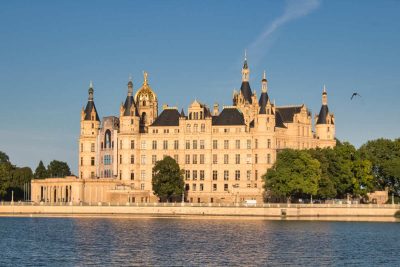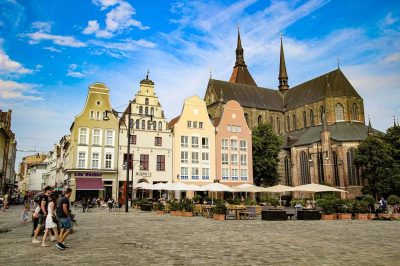Wismar is ideal for a short trip to the Baltic Sea. The former Hanseatic city already had several thousand inhabitants in the Middle Ages and flourished at that time because of its location. In the 14th and 15th centuries, countless Gothic buildings were erected, which still characterize the townscape today. Almost 200 houses with Gothic gables have survived all these years. Although many of them were later remodeled, this usually happened in such a wonderful way that Wismar today resembles a colorful mix of styles from several architectural eras. Of particular interest are the many Gothic churches, which all tell their own story and are among the most important Wismar sights. It is also for this reason that UNESCO has declared the old town of Wismar Germany, together with that of Stralsund, a World Heritage Site.
Wismar as a city of pirates and Swedes
Wismar is also proud of Klaus Störtebeker, the most famous German pirate, who was probably a citizen of the city. The city attracted not only rich merchants in the Middle Ages, but was considered a real pirate’s haven. The city still has its own character and differs from other Hanseatic cities in northern Germany. This is also due to the fact that it belonged to Sweden, at least officially, from 1632 to 1903. The Swedes expanded the city to the largest fortress in the Baltic Sea region, of which, however, nothing can be seen today. In this article I would like to introduce you to the most beautiful Wismar sights and give you a few practical tips for your planning.
World Heritage House
In the World Heritage House (Welterbehaus), which is open to the public free of charge and also houses the tourist information office, you can learn about the history of the city. Here you can find out how Wismar came into being and how the many old office buildings were built. The beautifully restored building is located in Lübsche Straße. It was once part of the Amber Route – the most important trade route in the region. But not only the exhibition, but also the building are worth seeing, because it has Renaissance ceilings, but above all an impressive salon. This was furnished in the 19th century by the then owner with a mural painting made in Paris, which is unique in this form in the world and shows the Greek Argonaut saga.
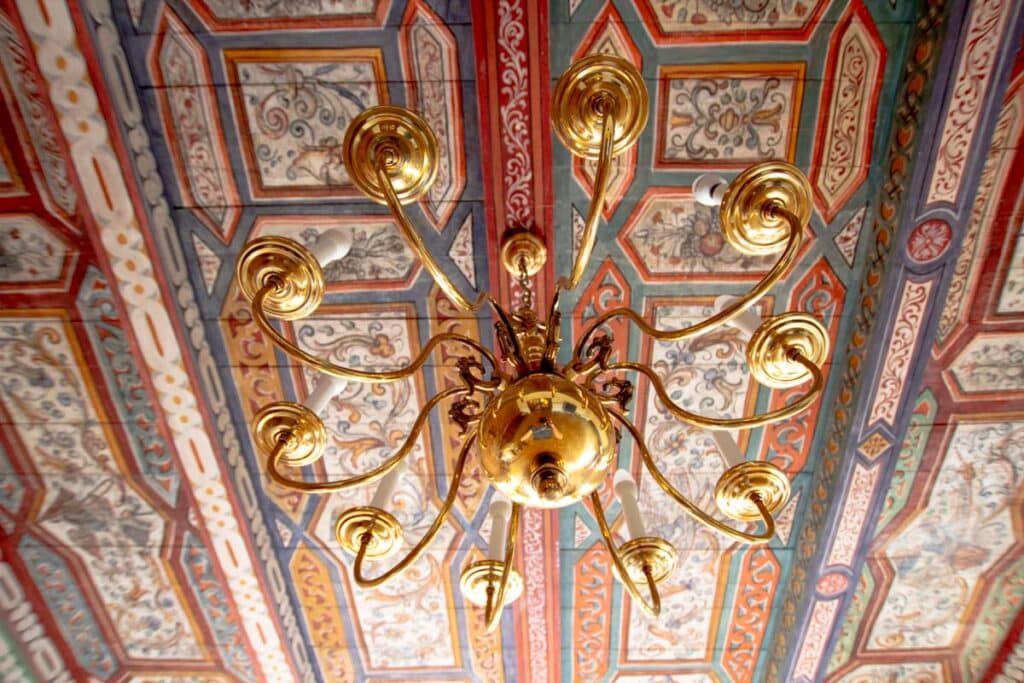
Hospital Church (Church of the Holy Spirit)
From the outside, the neat brick building looks quite something, but the real treasures of the Hospital Church are hidden inside. The church, like many others in the city, was built in the 14th century. However, the ceiling collapsed here in the 17th century. For lack of money, the people of Wismar decided to provide it with a cheap wooden ceiling. So that it was not so noticeable, they decorated it with wonderful paintings, which have survived to this day.
Church windows
But the greatest treasure of the church is a window, designed in the 14th century, which miraculously survived all the wars and fires to which the city was exposed during its long history. It is the only completely preserved Gothic stained glass window in the Baltic region and was once originally located in St. Mary’s Church.
A church for the sick
But why is the church actually called Hospitalkirche? In the past, a infirmary was attached here, where the sick were treated. You can still see the small rooms for the sick in the church, separated from each other by wood.
A police station in the church
The inner courtyard of the Hospital Church is also beautiful. There used to be a cemetery here, but today you can relax here. It also serves as a fictional police station for the popular German series SOKO Wismar.
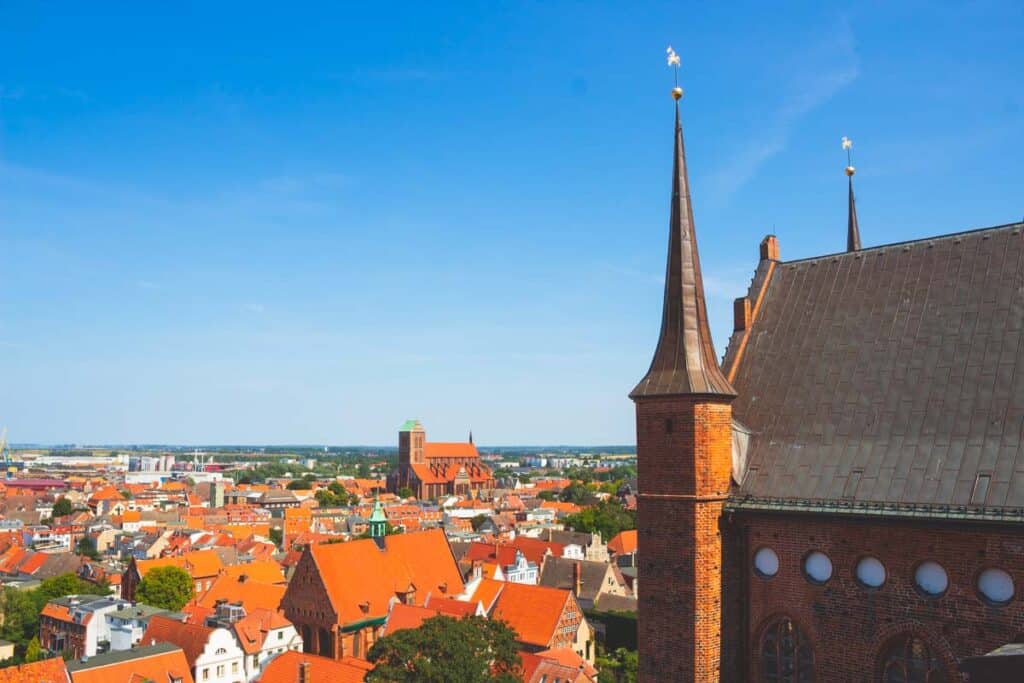
Georgenkirche (St. George’s Church)
The filigree brick church was built in its present form in the 15th century. The dimensions alone are impressive: the area is 3300 m², the nave is 25 meters high and a whole 6.5 million bricks were used here, an almost unbelievable number given the technical possibilities at the time. Unfortunately, the church was badly damaged during the Second World War and then only provisionally secured. In 1990, a hurricane destroyed the roof. But at least the reconstruction began. The result is impressive and provides the perfect setting for exhibitions and concerts that take place here. You can also take an elevator and comfortably ride up to a viewing platform in the tower, from where you can enjoy a great view of the old town and the surrounding countryside.
St. Mary’s Church
St. Mary’s Church (Marienkirche), or rather the tower that remains of it, is located just a stone’s throw away from St. George’s Church. It was also heavily destroyed during the Second World War. The GDR city administration decided to level its remains except for the tower. Today, it stands pretty much alone with the rebuilt foundation walls. At least there are some modern works of art here. However, St. Mary’s Church is one of the most important Wismar sights not only because of its history: In the church tower you can see a free exhibition on the history of the church. The english 3D film “Bruno Brickstone” is also shown here, which vividly tells the story of the building and explains how the many brick buildings in Wismar actually came into being (3 €).
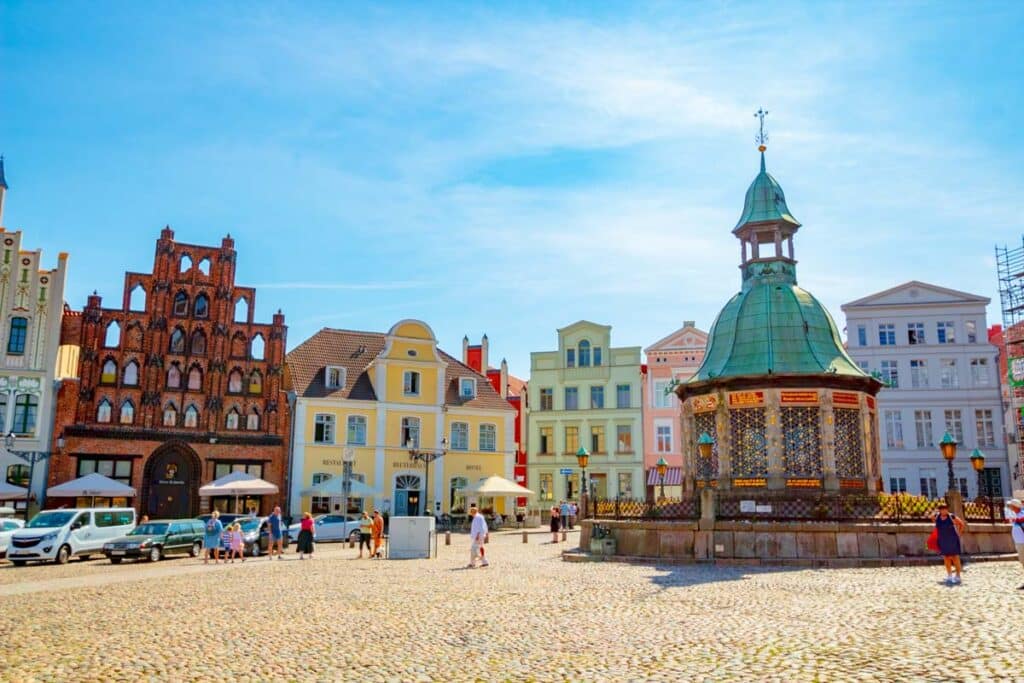
Market Square
Wismar’s market square is one of the most beautiful in the region – and one of the largest. It covers an entire hectare and is surrounded on all sides by beautiful buildings. Also remarkable is the cobblestone pavement from the 16th century. While the classical town hall stands in the center of the market square, the 16th century fountain house is the most striking feature. It looks a bit like a small church and was built in the style of the Dutch Renaissance. By the way, it is most beautiful on the market square on Tuesdays, Thursdays and Saturdays, when many merchants offer their regional goods here.
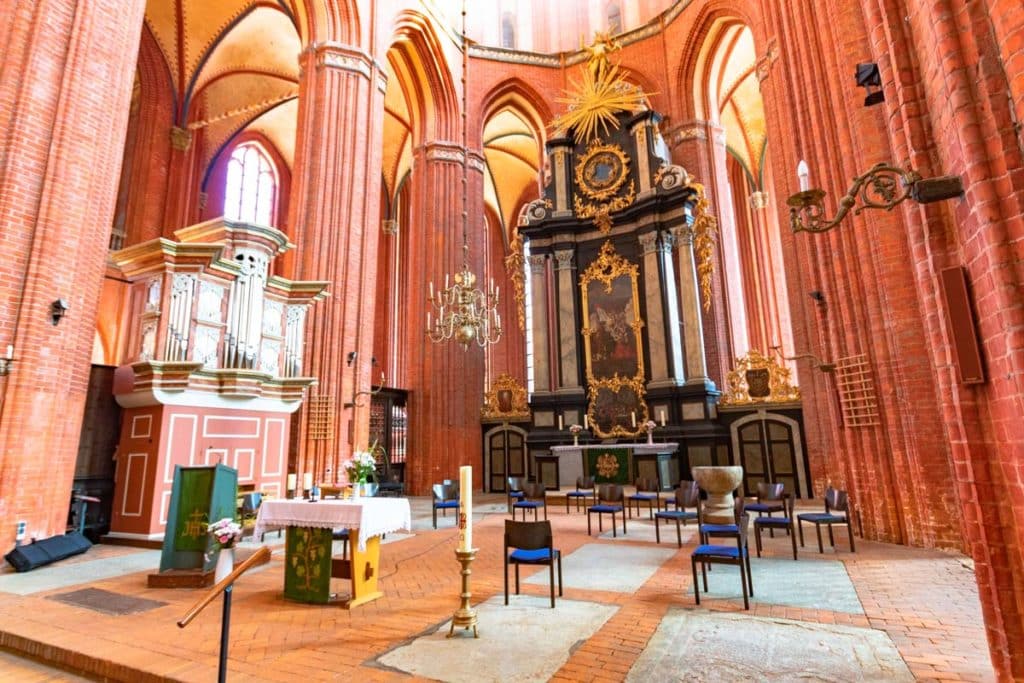
St. Nicholas Church (Nikolaikirche)
St. Nicholas Church was also built in the brick Gothic style and once served as a place of worship for fishermen and sailors. When entering the church, your mouth will probably remain open. The beautiful fresco above the cash register has survived all these years almost unscathed. There are many altars and works of art here that have been gathered from other churches. The most beautiful altar once stood in St. George’s Church and, with a width of over 10 meters, is the largest in the entire Baltic region. On its front side there are 42 carved figures of saints, while the back side was decorated with valuable pictorial panels. St. Nicholas Church also serves as a venue for events and a small exhibition also informs about its history.
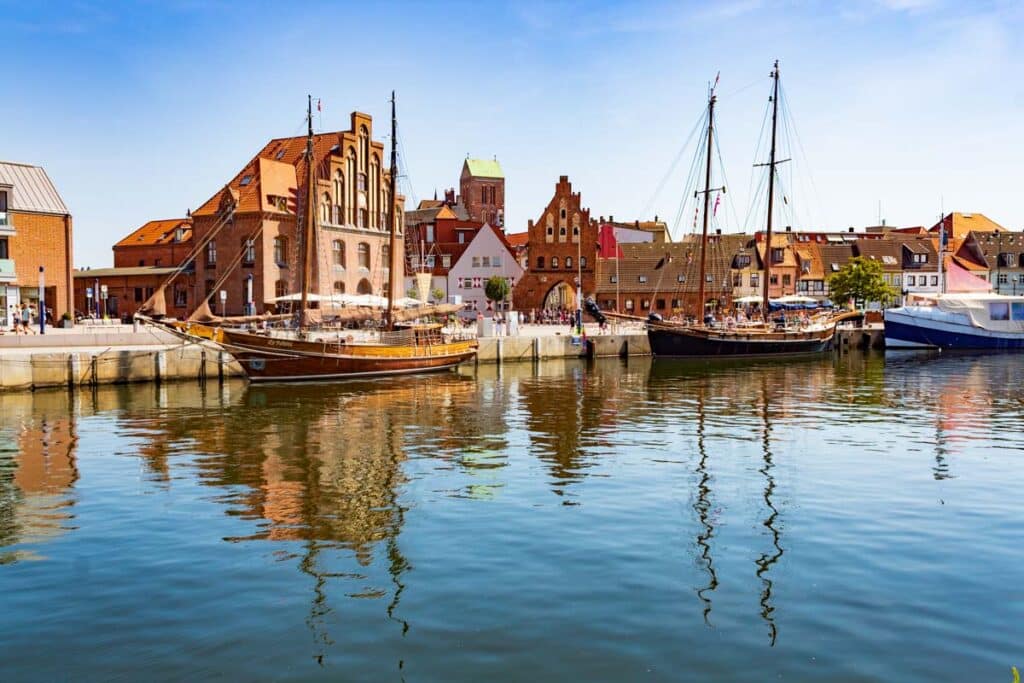
Port
Wismar owes its numerous historic buildings to its unique location on two important trade routes and its natural harbor. It was only because of the harbor that the city could become so wealthy in the 14th and 15th centuries that all the magnificent merchants’ quays could be built. It was also here that the famous cogs, the merchant ships of the Hanseatic League, were built. Of course, the port still exists today. It is divided into a modern and a historical part. While in the modern part of the harbor goods are loaded and cruise ships dock, in the old harbor you can stroll leisurely along the shore, drink a coffee and photograph the many beautiful ships that are anchored here. From here also start the harbor tours, which I describe below.
Which tours to the Wismar sights are worthwhile?
- The tourist information office offers a whole range of tours. Whether you book a classic city tour, follow in the footsteps of SOKO Wismar, or go out with the night watchman, you will learn everything you need to know about the city. I can particularly recommend the tour with the friendly pirate Störtebeker, who knows Wismar like the back of his hand.
- With Adler-Schiffe you can make a relaxed tour through the port of Wismar. You start at the old port, but on the way you also pass the modern part of the port with its loading cranes and cruise ships.
Where to eat and drink?
- Reuterhaus, Am Markt 19. A cozy restaurant on the market square named after the poet Fritz Reuter, whose publisher once worked here. Here you can enjoy classics of Mecklenburg cuisine in a stylish ambience. There is also a hotel attached.
- Alter Schwede, Am Markt 22. Next to the Reuterhaus is another good place, whose roots go back to the 19th century, when there was still a pub here. Especially fish fans will get their money’s worth here.
- Frische Grube, Scheuerstraße 1. Christian Müller cooks delicious dishes for his guests. Fish and meat. Great atmosphere.
Where to stay overnight?
- Pension Chez Fasan, Bademutterstraße 20A. In the family-run guesthouse in the old town, you can get a single room equipped with everything you need for as little as 33 euros per night.
- Hotel Alter Speicher*, Bohrstraße 10. As the name (Old Granary) suggests, you can stay here in an old, beautifully restored warehouse. The breakfast is great, and the hotel also offers various booking packages, so your Wismar vacation is guaranteed to be unforgettable.
Book recommendation
There is not much literature about Wismar Germany in English, but this tour guide in German, English and Swedish is definetely worth it’s price.
No products found.
No products found.
No products found.
Did you like our trip to Wismar Germany? What are the most beautiful Wismar sights for you? Let us know and write us a comment!


